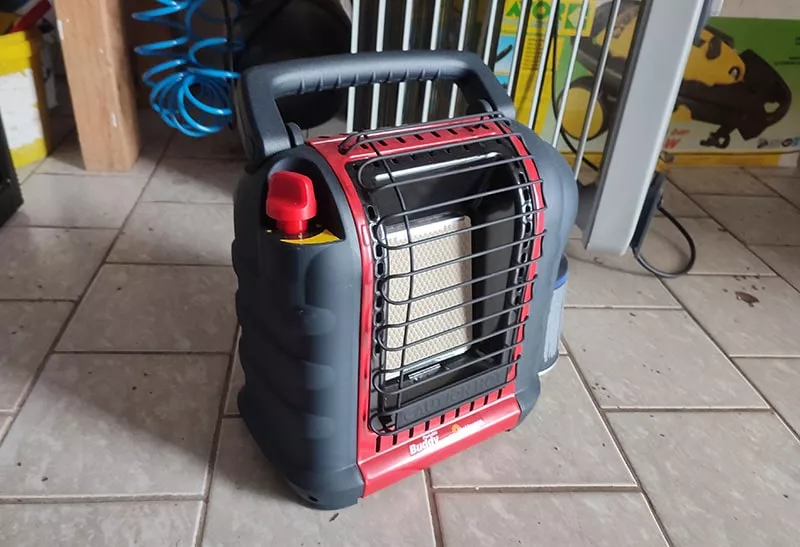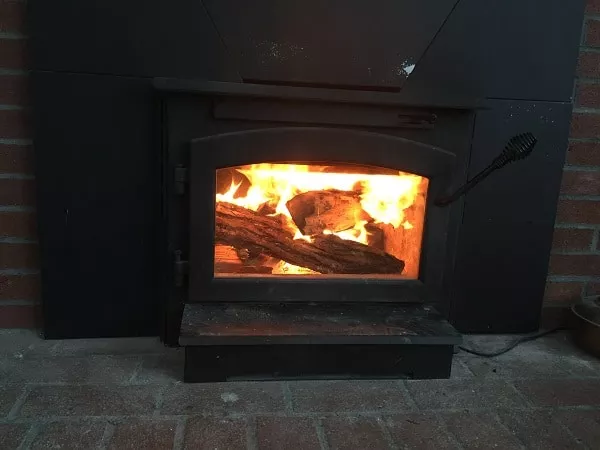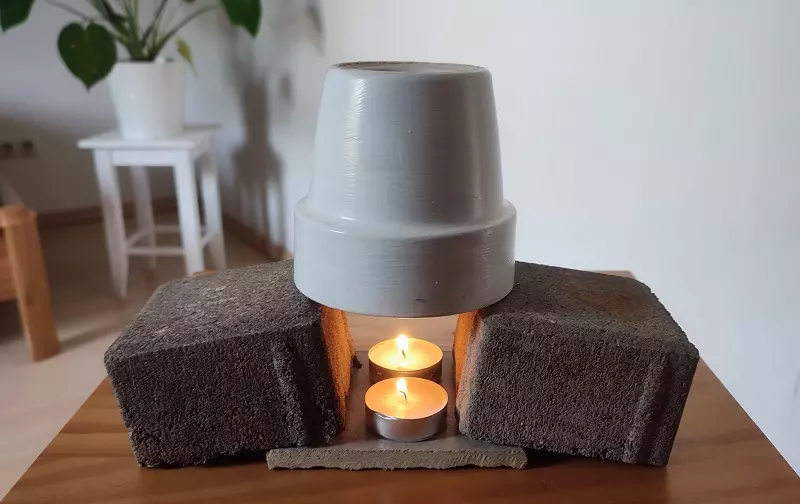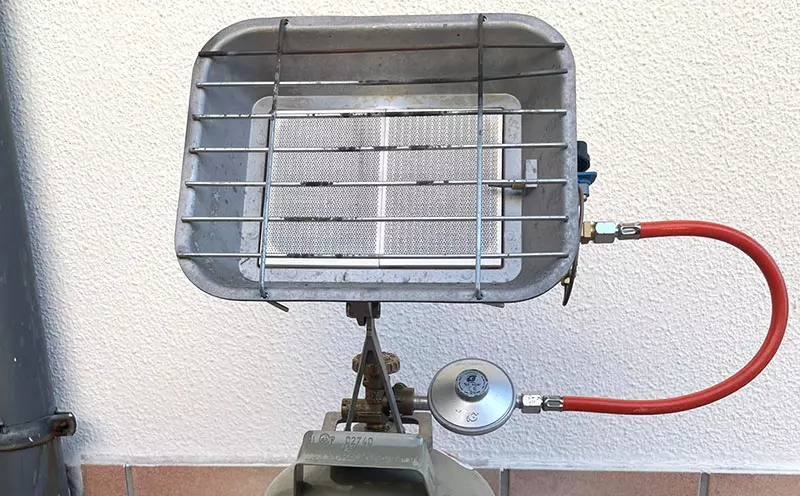Sometimes you have to keep warm without electricity. Whether in an electricity outage or in an off-grid location, it’s always good to know the best possible ways to heat a room without electricity.
In this article, I’ll guide you through the most cost-effective & least energy-intensive ways to heat a room without electricity.
After reading it thoroughly, you’ll know plenty of alternative heat sources. Some of them can heat entire houses, like wood, others are emergency heat methods that require next to no energy.
Methods for Heating that don’t require Electricity
So, let’s have a look at the full list of ways to heat without electricity!
1. Propane Heaters
For emergencies such as an energy outage, propane gas is very practical because you can store it over long periods of time. The gas is always available and never degrades.
Propane gas is cheap and you can fill it up at a local hardware store.
To heat using propane gas, I recommend this Mr. Heater propane heater (click here to view it on amazon).
This model is sized for large rooms and is able to keep your entire family heated for several days, if not weeks depending on how economically you use the propane.
The Mr. Heater propane heater can output 18,000 BTUs per hour, which is the equivalent of 3 electric space heaters on full power.
 The Mr Heater Buddy is my favorite propane heater!
The Mr Heater Buddy is my favorite propane heater!
So, how long does it last?
“A standard-sized 20-pound propane cylinder holds approximately 430,000 BTUs of liquid propane.”
On full power settings, the Mr. Heater propane heater drains a 20-pound propane tank in 23.8h. So, it will last you almost one full 24 hours.
Durability of propane gas heaters
However, in emergency situations, you’ll never power the heater on full throttle. You can use it on 3 different heat settings:
| Propane Heater Setting | BTU/h | Runtime (20 lb tank) |
|---|---|---|
| Low | 4,000 BTU/h | 108 hours |
| Regular | 9,000 BTU/h | 48 hours |
| High | 18,000 BTU/h | 24 hours |
So, on the lowest 4,000 BTUs per hour setting, which is the equivalent of an electric space heater running on 1,100W of power, you are able to heat for a full 108h continuously.
This amount of power is enough to keep an average 150 sq. ft to 250 sq. ft. living room at a comfortable temperature of at least 64°F even in the cold winter.
If the 18,000 BTUs rating is too high for your needs, you can also get a smaller version of this model. However, I am a friend of always having the option to produce more heat if needed. You can always turn down the settings to match a lower heat output.
According to learnmetrics.com, refilling a 20 lb propane tank costs $15.17 at $3.90 per gallon.
Don’t forget you can always keep multiple propane tanks at home!
2. Wood Burning Heaters
Wood is the most independent source of heat. It has multiple advantages. The first is, of course, as we’ve already seen the best cost-efficiency of all heating methods.
Wood produces the most heat per dollar invested. Also, you can stack it and store it for electricity outages.
However, if you use wood as a heat source, you have to put in the work. Preparing a cord of firewood involves transporting wood to your home, cutting, chopping, stacking, and drying it.
The more work you do yourself, the less money you will have to spend.
Due to its large heat capacity, wood is a powerful heat source and well-suited for heating large rooms.
For a living room, you need around 1 cord of wood (128 cubic feet, or 3.6 cubic meters) per year. This depends on your desired room temperature and the exact room size.
Here’s a table listing the number of cords of wood you need per year for different room sizes and target temperatures.
| Room Temperature | 150 sq. ft. room | 300 sq. ft. room | 450 sq. ft. room |
|---|---|---|---|
| 65°F (economic) | 0.5 cords/year | 1 cord/year | 1.5 cords/year |
| 70°F (normal) | 1 cord/year | 1.5 cords/year | 2 cords/year |
| 75°F (comfortable hot) | 1.5 cords/year | 2 cords/year | 2.5 cords/year |
The forestry department of Utah State University found that you get 27.5 Million BTUs of heat per cord of Beechwood. Oak delivers up to 30.7 million BTUs of heat energy per cord.
They are the best types of wood for heating.
 Wood-burning heaters (such as this wood stove) are very reliable & outage-safe. But they require installation.
Wood-burning heaters (such as this wood stove) are very reliable & outage-safe. But they require installation.
Cost-efficiency of different wood types
Here are more types of wood sorted by the heat per cord. Additionally, I researched the cost of each wood species and found which type of wood is the most cost-effective.
| Wood Species | Heat per Cord (Million BTUs) | Cost per Cord (USD) | Cost per Million BTU (USD) |
|---|---|---|---|
| Alder | 17.5 | $200.00 | $11.43 |
| Apple | 27.0 | $300.00 | $11.11 |
| Ash, Green | 20.0 | $350.00 | $17.50 |
| Aspen | 18.2 | $120.00 | $6.59 |
| Beech | 27.5 | $300.00 | $10.91 |
| Birch | 20.8 | $300.00 | $14.42 |
| Douglas-fir | 20.7 | $150.00 | $7.25 |
| Elm | 20.0 | $200.00 | $10.00 |
| Juniper | 21.8 | $300.00 | $13.76 |
| Larch | 21.8 | $300.00 | $13.76 |
| Locust | 27.9 | $300.00 | $10.75 |
| Maple | 25.5 | $300.00 | $11.76 |
| Oak | 26.2 | $300.00 | $11.45 |
| Pine | 21.1 | $120.00 | $5.69 |
As you see in the table, most sorts of common firewood such as Oak, Birch, and Beech are in the $10 - $14 per Million BTU range.
Pine and Douglas appear very cheap. However, Pine does not grow in areas where firewood is needed.
Aspen is probably that cheap (around $6 - $7 per million BTUs) because it only grows in cold regions, where lots of firewood is available.
If you live in a moderately cold climate, your best bet is Oak, Birch, and Beech, which are the most popular kinds of firewood.
Side fact:
All types of wood have a better cost-efficiency than any other heat source we looked at. It does not matter, which type of wood you use. As long as you use wood, you are already getting more heat for your money than with any other heating method.
3. Body Warmth
Animals, especially large ones such as cows produce a significant amount of body heat. However, using live animal bodies’ heat is not an option for most households.
That’s why we did not include animals in the final comparison table listed at the beginning of this article. Also, it is very hard to accurately determine the cost of heating with live animals.
So, this is just a theoretical investigation:
One cow produces 4,500 - 6,000 BTUs per hour ( source). One BTU per hour is around 0.293W. This means a single cow produces anywhere between 1,300W and 1,700W of heating power.
That is the equivalent of an electric space heater running on full power.
With a 1,500W space heater, I can get my living room toasty warm. It’s incredible that a cow can do the same.
But I don’t want a cow in my living room!
In an emergency, it’s always good to gather the family together. More people create more heat!
4. Dried plant or animal material
Another emergency heat source we have a short look at is dried plants and animal dung.
I was traveling Nepal with a friend once. In the Himalayan mountains, there is no electricity and no wood for heating. Gas is expensive since it has to be carried up the mountains in heavy bottles.
The local’s favorite way of heating is to mix dried plants (grasses, bushes) with dried animal dung (usually cows, horses, and yaks).
The everyday hunt for animal dung yielded enough material to get a full evening of heat out of it!
You can even mix the dried materials with plant oil for more heat.
Since all of that is only imaginable in emergency situations, I’ll leave it here as an anecdote and I don’t include it in the cost-efficiency analysis.
 These simple Nepalese wood stoves are fired with Yak dung!
These simple Nepalese wood stoves are fired with Yak dung!
5. Candles
A candle produces, depending on the model, around 40W to 80W of power. To match the power of a 1,500W space heater, you would need at least 18 80W candles.
A single candle costs at least $0.05. Out of a candle, you can expect to get 352 BTUs of heat. This results from the heat capacity of candle wax multiplied by the weight of a single tealight. I’ll spare you the details.
With a $0.05 tealight and 352 BTUs heat capacity per tealight, the cost for a million BTUs would be $142.04.
Sounds high, right? Especially when we compare it to the $10 - $14 per million BTUs of most wood types.
However, that’s only the lower end of the spectrum.
Candles are too expensive for heating without electricity
In an electricity outage, or in times leading up to electricity outages, the demand for tealights rises sharply. The supply of wax is more limited than the supply of wood.
This means that candles either go out of stock, or their prices rise sharply.
We’re not in a drastic situation right now. But looking online, I can find several offers for tealights where a single tealight costs $0.26 to $0.33, or even more.
With these inflated prices per candle, a million BTUs in candles cost $738.61 to $937.46.
In addition to the incredible cost of heating with candles, a single candle burns only 2-3 hours. This means that you will have to constantly change candles. And you’ll end up with a lot of waste.
I hope you agree with me that heating with candles is absolutely impractical. Even in an emergency.
6. Flowerpot Heater
Flowerpot heaters are a mutated form of heating with plain candles. A lot of people mistakenly think that candles placed below an upside-down flowerpot produce more heat than the candles alone.
However, according to the laws of thermodynamics that is physically impossible. A single tealight has a certain heat capacity.
Changing the structure around a candle might have a slight impact on how quickly the heat is released, but it does not extract more heat energy from the candle.
In physics terms: You can change the burning power of a candle, but not the heat energy stored inside.
If you manage to build a flowerpot heater that makes candles burn with more power, this just causes the candles to burn up more quickly, leaving you with a net zero effect.
Still, I wrote a full article on how to build a terracotta clay pot heater, analyzing different types of candles, types of flowerpots and checking the physical possibilities.
Have a look, if you are interested.
For heating a room without electricity, a flowerpot heater definitely works. However, the cost of heating with candles is too high and other options such as propane or wood are a lot more practical.
 Flowerpot heaters are trending. But candles produce only little heat and are comparably expensive!
Flowerpot heaters are trending. But candles produce only little heat and are comparably expensive!
7. Run a space heater off a generator
You can run a space heater off a generator. However, this will quickly drain your fuel supply. To heat without electricity, you should rather power an electric blanket off your generator.
Electric blankets consume only around 50W, which is significantly less than the 1,500W required to run a space heater.
A generator lasts 30x longer if you use an electric blanket instead of a space heater.
8. Power bank plus electric heating blanket
Let’s assume you have a power bank at hand. How much heat can you get out of a fully charged power bank?
First of all, most large power banks have a capacity of 20,000mAh. If your power bank is able to supply a 5V load, then the overall capacity (in Watt-hours) is 20,000mAh / 5V = 100Wh.
With 100Wh you could power a 50W electric blanket on full power for 2 hours.
The cost of charging a 100Wh power bank is $0.03 at most. This is even a slight overestimate since the official US average electricity rate is $0.14 per kWh. I like to use conservative numbers, so I assumed $0.30 per kWh.
This results in a cost-efficiency of $87.98 per million BTUs. That’s quite a high number, somewhere in between propane gas and candles.
However, with an electric blanket powered off a generator, you don’t heat the entire room, but just one person directly. So, instead of dispersing each BTU of heat energy in your room’s air, you apply it directly to a person’s body.
This is a significant difference since you feel each BTU immediately. And that’s why I conclude:
Electric blankets powered off a power bank have a relatively high cost per BTU due to high electricity rates. However, because the electric blanket directly touches you, each BTU feels a lot warmer than with other heating methods (which heat the air instead). Electric blankets powered off a power bank (or generator) are, therefore, a very efficient way to keep warm without electricity.
9. Generator or power bank plus terrarium heater
You can achieve the same effect as with heating with an electric blanket using a terrarium heater.
Terrarium heaters are thin heating stripes that you can put on the floor and put your feet on them.
So, they are like electric blankets, but just for the feet.
Actually, they were made for heating terrariums, but why not use them in an emergency?
Here’s why I include them in this article:
One terrarium heater consumes as little as 7W of power. That’s only a tiny fraction (<1%) of what an electric space heater consumes. And it’s just 14% the power of an average electric blanket.
This means that it will last you 7x longer than an electric blanket.
In an extreme emergency, you can connect a terrarium heater to a power bank and heat your feet for many hours, if not days, before the energy runs out. On a generator, a terrarium heater will last months!
The cost-efficiency of a terrarium heater in combination with a power bank or generator matches the cost-efficiency of an electric blanket and it directly depends on your personal electricity rate.
2 Principles to Heat Effectively without Electricity
In an emergency, when you have to heat your room without electricity, you want two things
- stay warm
- spend as little of your heat resources as possible
Here’s how you can do that:
First Principle: Heat the person, not the room
The most important principle to heat without electricity as cheap and economically as possible is to heat the person, not the room.
This means:
Always sit directly in front of the heat source. The heat has to radiate directly toward your body.
Always prefer conductive heating methods (such as electric blankets, hot water bottles, or merely touching the stone slabs in front of your wood stove with your feet), over whole-room heating methods.
The air in your room is an insulator. To heat effectively without electricity, prefer to heat only rooms where people are present. Avoid heating empty spaces.
You can even convert general whole-room heating methods to conductive heating methods:
- Heat a hot water bottle using your wood-burning stove
- Sit directly in front of a heat source
- Touch stone slabs (or something else that absorbs heat) directly in front of your heat source with your feet
Second Principle: Dress warmly
Not only should you always aim to apply the heat directly to your body, you should also dress warmly to keep the heat.
Wool and cotton are great for heat retention. Prefer heavy materials over light ones.
Don’t be afraid of wearing 3-4 layers on your upper and lower body.
And don’t forget to insulate your feet well: Two pairs of socks are better than just one.
Wear a hat if it’s very cold.
Further Analysis: Cost Of Different Heat Sources
A wood-burning stove is the most cost-effective way to heat a room without electricity with just $10.91 per Million BTUs. The second best option is propane gas with $35.28 per Million BTUs. For emergencies, wood is the preferable resource. For installation-less use, a propane heater is the better heater choice.
The table below lists the capacity (in BTUs) of different loads of heat sources. Additionally, you’ll find the cost for a full refill. And accordingly, the cost-efficiency, which measures the cost (in Dollars) to get a million BTUs of the heat source in question.
| Heat Source | Cost Per Unit Of Heat (in $ per Million BTU) |
|---|---|
| Wood | $11 |
| Propane | $35 |
| Electricity | $87 |
| Candles | $142 |
The data for more types of wood is listed in the section about wood heating further below. You can check the sort of wood that is most available in your area there.
For the power bank values, I assumed a load of 5V (for hooking up a USB heating blanket) and an electricity rate of $0.30 per kWh for charging. This is a conservative estimate and more than double the current US average of $0.14 per kWh.
From the data collected, you immediately see that heating with wood is the most cost-effective way to heat a room without electricity. On the other hand, heating with candles is financially unfeasible.
For the candle data, I even used the cheapest tealight models I could find (from Walmart, which is $5 for 100 tealights). Still, it’s by far the most expensive way to heat a room without electricity.
If you use more expensive tealights, the cost-efficiency degrades quickly. Tealights that cost $0.26 - $0.33 have a cost-efficiency of $700 - $900 per million BTUs. Horrible. Never heat with candles if you want to get the most value for your money!
Tealights are 10x to 90x more expensive than wood and 4x to 25x more expensive than propane gas.
How to Keep Safe Heating without Electricity
With wood-burning or fuel-burning heating methods comes the risk of toxic gas accumulation in your room.
Make sure to vent your room occasionally to let fresh oxygen in.
Also, make sure that the heater you use is well-built and, ideally, certified. Most certified propane heaters and wood stoves are adjusted for an “ideal burn”, which burns wood or gas without waste materials and without toxic gases.
When using a heating blanket or a terrarium heater for your feet, avoid hot water bottles to reduce the risk of an electric shock.
Conclusion
The most cost-effective and versatile method to heat a room without electricity is a wood-burning stove.
The second best off-grid heating method in an energy outage is propane gas, which is similarly affordable.
If you don’t have a wood-burning stove available, always keep a propane heater with a 20-lb propane tank around. This saves you the installation cost of a wood stove.
If you do have a wood stove, then always keep at least half a cord of firewood around your house or cabin. Even if you don’t actively use it. In an electricity outage, you’ll be happy to be prepared.
